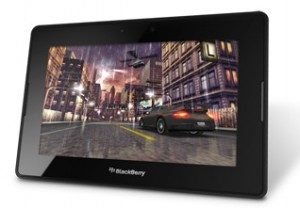 While the big talk in tablets lately has been all about newly affordable Android based devices like the Kindle Fire and Nook Tablet, RIM has yet to drop entirely out of the race. Their previous effort, the BlackBerry PlayBook, failed to excite as much interest as they had hoped (partly due to the lack of basic functionality like an email client). This past week, however, brought us the new PlayBook 2.0. It is a new and improved device on a completely upgraded operating system that packs possibly the most impressive performance available at the moment in the $200 area. Will this be enough to propel the floundering RIM into the lead?
While the big talk in tablets lately has been all about newly affordable Android based devices like the Kindle Fire and Nook Tablet, RIM has yet to drop entirely out of the race. Their previous effort, the BlackBerry PlayBook, failed to excite as much interest as they had hoped (partly due to the lack of basic functionality like an email client). This past week, however, brought us the new PlayBook 2.0. It is a new and improved device on a completely upgraded operating system that packs possibly the most impressive performance available at the moment in the $200 area. Will this be enough to propel the floundering RIM into the lead?
While the Nook Tablet has done a fairly good job of demonstrating that numerically superior hardware isn’t necessarily what you need to come out on top in the tablet market, the new PlayBook is a completely different experience. In addition to addressing the problems that their original tablet OS offering had RIM has included support for Android app conversion by developers, a fully featured web browser at least the equal to anything else available on a mobile device today, and more. The hardware includes everything one would expect based on similarly priced competition, along with Bluetooth support, GPS, microphone, dual HD cameras, HDMI 1080p output, and slightly better internal speakers than other offerings. This isn’t an insignificant upgrade and the performance in a hands-on test backs it up quite well.
The only thing working against the BlackBerry comeback seems to be the lack of a competitive ecosystem. While there are certainly apps available, many of those that you would expect to see, based on top sellers in Apple, Google, or Amazon’s App Stores, are simply absent. Of those that do make an appearance, there are rarely free versions since RIM does not permit any sort integration with the company’s own advertising service and there are still questions among developers as to the long term viability of third party advertising integration based on early reports that such would not be supported on PlayBook OS 2.0. For now you can get a great device with a fair number of apps, but the entire ecosystem is smaller than Amazon’s in-house Android App Store which is itself often complained about as being too sparsely populated. Learn how to open BIN file.
Unlike the original PlayBook, this is not a device that is shipping with a large number of inherent flaws as best I can tell. If it came down to choosing right this minute then the Kindle Fire is still probably the better choice based on useful apps, but that will not necessarily always be the case. The biggest factor will be user adoption. If enough BlackBerry tablets get sold, developers will start paying attention and the ecosystem will flourish. RIM already claims that their developers make better returns than any other platform’s, which could be a big plus given a larger user base. The trick will be getting the word out and keeping people interested in the near future. At the same price as a PlayBook, customers can grab a $200 Kindle Fire and have most of what they want right this minute rather than having great hardware without the desired functionality. We’ll have to keep an eye out to see how they choose to address this.